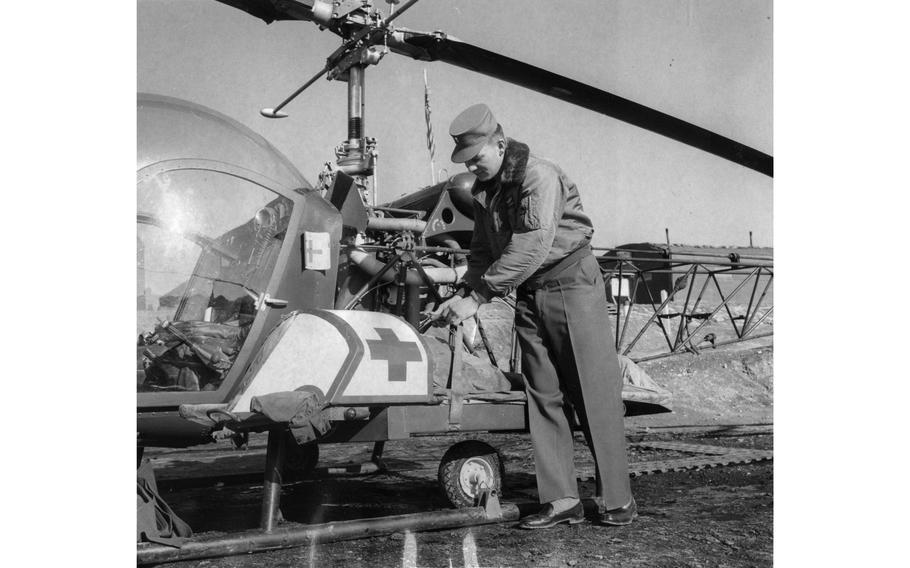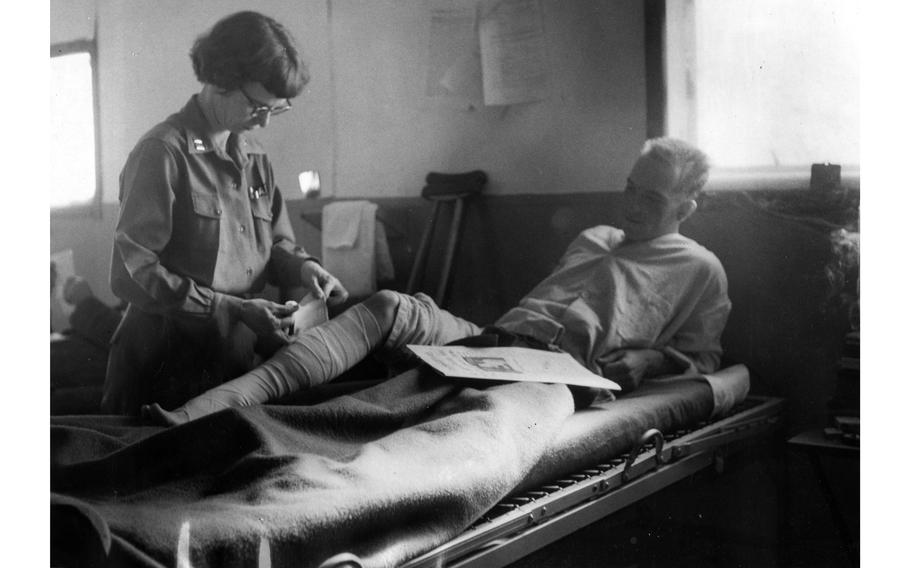
First Lt. Paul Blomquist secures a patient to the outside of his Bell H-13 Sioux helicopter. Blomquist, who piloted the air ambulances of the 54th Medical Detachment, was one of five Army fliers ready to take off in the “bubble” chopper within five minutes of getting a call to evacuate a soldier. The helo was equipped with external stretchers — one on each side of the aircraft — to transport wounded soldiers quickly from battlefield to hospital. When only one patient was flown, sandbags were strapped to the other side to balance the weight. (Al Ternes/Stars and Stripes)
WITH U.S. 24TH DIV., Korea — Sometimes a soldier balks at flying on his back outside a helicopter, 700 feet in the air.
"I just tell him 'no sweat'. The ride will last 15 or 20 minutes, and if he will keep still, he'll enjoy it a heck of a lot more," says 1st. Lt. Paul Blomquist, who pilots the air ambulances of the 54th Medical Detachment.
Blomquist is one of five Army fliers ready to take off in the "bubble" choppers within five minutes after getting a call to evacuate a soldier suffering gunshot wounds, skull fractures, broken bones, hepatitis or hemorrhagic fever.
"If the doctor says they have to go by helicopter, they have to go," Blomquist adds.
"Often people with brain concussions are scared." Blomquist "comforts them a little," and wraps the patients in sleeping bags before fastening them down with safety belts. When only one patient is flown, sandbags are strapped to the empty litter on the other side to balance the weight. Once in the air, the plane's balance is so "critical" that Blomquist says his hands on the control stick can feel a patient's "slightest movement outside."
If a delirious soldier with a brain injury manages to unfasten his safety belt, unzip his sleeping bag and thrash around in mid-air, Blomquist must set the chopper down immediately to preserve its delicate balance and save the life of his patient as well as himself.
"Then I tie down with anything I can find, telephone wires or ropes," he says.
Besides the five helicopters, two ambulances stand ready to deliver the 24th Division's sick and wounded to the hospital adjoining the chopper field.

Capt. Virginia Brown, chief nurse at the quonset hut hospital adjecent to the 54th Medical Detachment’s air ambulance helicopter field, adjusts the leg bandage of a wounded soldier. (Al Ternes/Stars and Stripes)
"A few soldiers are nervous after flying outside the choppers, but most of them are so sick they don't care whether they're in the air or not," reports Capt. Virginia Brown, chief nurse at the hospital.
The quonset hut hospital here is equipped with an X-ray lab, pharmacy, surgery room, dental clinic, library, hobby shop and a patients' mess which opened Thursday.
Essential equipment and supplies remain packed and ready to move in a few hours in case of any emergency.